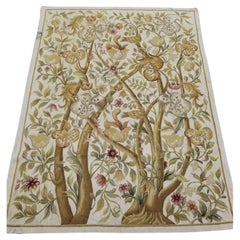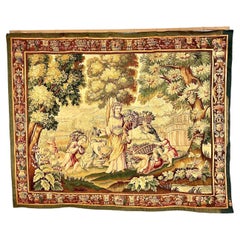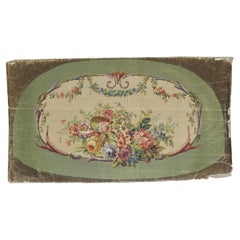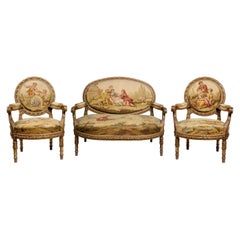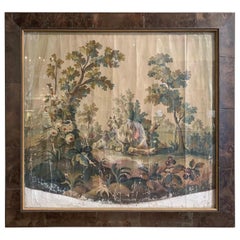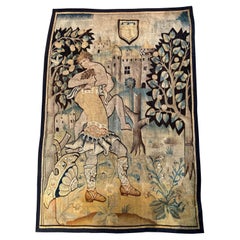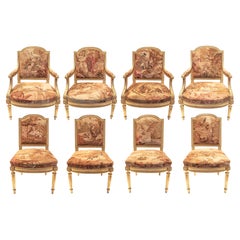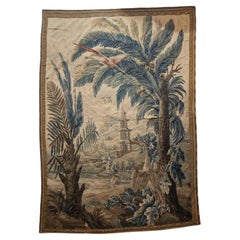Aubusson Manufacture Furniture
16
to
1
9
6
16
16
16
16
6
3
2
1
1
7
9
11
8
7
7
4
15
15
46
118
46
43
33
Style: Louis XVI
Creator: Aubusson Manufacture
19thc. French Antique Louis XVI style Floral Aubusson Wall Hanging / Tapestry
By Aubusson Manufacture
Located in Opa Locka, FL
19thc French Antique Louis Rococo style Floral Aubusson Tapestry. I found this beauty in Nice France. There is a small stain on border top left. Not detracting at all. Birds, trees p...
Category
1880s Louis XVI Antique Aubusson Manufacture Furniture
Materials
Tapestry
French Aubusson Tapestry, 'Lady and Children Picking Up Fruits'
By Aubusson Manufacture
Located in LA CIOTAT, FR
A fine Aubusson tapestry depicting a robed lady and several mischievous children bearing baskets of fruit, in a typically rural and architectural-themed landscape. A wide border on a...
Category
19th Century French Louis XVI Antique Aubusson Manufacture Furniture
Materials
Wool, Silk
19th Century Aubusson Cardboard with Flower Basket Decor
By Aubusson Manufacture
Located in BARSAC, FR
Painting on carton canvas from the 19th century in the Louis XVI style decorated with a flower basket in an oblong medallion made up of foliage and floral garlands.
Project used as ...
Category
Late 19th Century French Louis XVI Antique Aubusson Manufacture Furniture
Materials
Paint
19th Century French Aubusson Floral Tapestry Gouache on Paper in Gilt Frame
By Aubusson Manufacture
Located in Dallas, TX
Decorate a bedroom wall with this colorful, antique Aubusson drawing cartoon. Created in the city of Aubusson, France circa 1820, the simple and elegant gouache on paper is hand pain...
Category
Early 19th Century French Louis XVI Antique Aubusson Manufacture Furniture
Materials
Giltwood, Paper
19th C. French 3 Piece Giltwood Salon Suite, Settee, Pair Armchairs, Tapestry
By Aubusson Manufacture
Located in Madrid, ES
Upholstered in fine Aubusson tapestry fabric, this 19th century French Louis XVI style three-piece salon suite includes a settee and two matching armchairs.
The carved giltwood furn...
Category
19th Century French Louis XVI Antique Aubusson Manufacture Furniture
Materials
Tapestry, Giltwood
18th Century French Aubusson Tapestry Gouache on Paper with Frame and Glass
By Aubusson Manufacture
Located in Dallas, TX
Decorate a wall with this colorful, antique Aubusson drawing cartoon. Created in the city of Aubusson, France circa 1780 and set in a carved frame with gilt trim and protected with g...
Category
Late 18th Century French Louis XVI Antique Aubusson Manufacture Furniture
Materials
Giltwood, Paper
18th Century French Aubusson Cartoon Gouache on Paper in Gilt Frame with Glass
By Aubusson Manufacture
Located in Dallas, TX
Decorate a living room wall or study with this elegant and colorful, antique Aubusson drawing cartoon. Created in the city of Aubusson, France circa 1760 and is set in a gilt frame, ...
Category
Mid-18th Century French Louis XVI Antique Aubusson Manufacture Furniture
Materials
Giltwood, Paper
19th Century French Louis XVI Aubusson Ladies Purse with Brass Strap and Lock
By Aubusson Manufacture
Located in Dallas, TX
This elegant ladies purse was handwoven in France, circa 1860. The small, antique purse is handmade using colorful Aubusson tapestry. The tapestry features two different scenes. On o...
Category
Mid-19th Century French Louis XVI Antique Aubusson Manufacture Furniture
Materials
Brass
18th Century French Handwoven Pastoral Verdure Aubusson Tapestry
By Aubusson Manufacture
Located in Dallas, TX
This large and elegant antique tapestry was crafted in Aubusson, France, circa 1760. The colorful wall piece features a country garden scene with goats, architectural elements and a ...
Category
Mid-18th Century French Louis XVI Antique Aubusson Manufacture Furniture
Materials
Tapestry
Louis XVI Tapestry at Cost Price
By Aubusson Manufacture
Located in Saint-Ouen (PARIS), FR
Old tapestry Louis XVI, by Aubusson.
France, late 18th century.
Category
18th Century French Louis XVI Antique Aubusson Manufacture Furniture
Materials
Tapestry
19th Century French Aubusson Tapestry Gouache on Paper in Carved Gilt Frame
By Aubusson Manufacture
Located in Dallas, TX
Decorate a bedroom wall with this colorful, antique Aubusson drawing cartoon. Created in the city of Aubusson, France circa 1820 and set in a carved gilt frame, the simple and elegan...
Category
Early 19th Century French Louis XVI Antique Aubusson Manufacture Furniture
Materials
Giltwood, Paper
18th Century French Handwoven Aubusson Tapestry, The "Colin-Maillard" Game
By Aubusson Manufacture
Located in Dallas, TX
This large, antique tapestry was woven in Aubusson, France, circa 1760. The colorful scene depicts a group of people playing the game "Colin-Maillard", or Blind Man's Buff, a very po...
Category
Mid-18th Century French Louis XVI Antique Aubusson Manufacture Furniture
Materials
Tapestry
18th Century French Handwoven Aubusson Verdure Tapestry with Fishermen
By Aubusson Manufacture
Located in Dallas, TX
This elegant and large antique tapestry was woven in the town of Aubusson, France, circa 1760. The rectangular landscape scene depicts fishermen...
Category
Mid-18th Century French Louis XVI Antique Aubusson Manufacture Furniture
Materials
Tapestry
Louis XVI Style Canapé Upholstered with Aubusson Tapestry, circa 1880
By Aubusson Manufacture
Located in Brighton, West Sussex
A Louis XVI style Canapé, upholstered with Aubusson tapestry depicting a scene from Aesop’s Fables.
French, circa 1880.
The small town of Aubusson, on the River Creuse in France, had a long history of producing elaborate and costly tapestries. They were known for their elegance and delicate colouring and often depicted romantic pastoral scenes derived from artists such as Boucher; historic scenes, inspired by classical mythology; or more formalized architectural vistas.
Aubusson was particularly noted for its finely balanced compositions of garlands and bouquets which became famous and sought after throughout Europe.
Aesop was by tradition a labourer who was a contemporary of Croesus and Peisistratus in the mid-sixth century BC in Ancient Greece. The various collections that go under the rubric "Aesop's Fables" are still taught as moral lessons and for centuries have been influential subject matter for artistic endeavour.
The Shepherd Boy and the Wolf:
In a village was a young boy who had a job watching the village's sheep. Two times he called out, "Wolf! Wolf!" Each time the villagers came running to help the boy. And both times the boy just laughed at the villagers and called them names. But then the wolf really did come and start eating the sheep. The boy called, "Wolf! Wolf!" but the villagers just ignored his calls. They thought he was just trying to trick them again. The wolf took his time and had a huge meal of the entire flock of sheep.
The Wolf in Sheep's Clothing:
Once upon a time there was a wolf who decided to disguise himself so he could get some food without working too hard. He took a sheep's skin and hung it over his body. Then he went into the sheep pasture and pretended to graze with the sheep. He fooled everyone. Even the shepherd didn't realize she had a wolf grazing with her sheep. Soon the shepherd moved the sheep into the barn and the wolf went with them. The barn door was closed and locked and the wolf was just about ready to have a nice meal when the shepherd came back. She decided she wanted some food for her meal. She grabbed the wolf who was still disguised as a sheep and killed him for her meal.
The Wolf and the Crane:
One day a wolf had a bone stuck in his throat. He called to a crane and hired him for a large sum of money to put her head in his mouth and remove the bone. The crane did as she was hired to do and got the bone out and then asked to be paid. The wolf just grinned and said, "Ha! You've already been paid. I let you take your head safely out of my mouth when I could have crushed you with my powerful jaws”.
The Wolf and a Mountain Goat:
One day a wolf looked up and saw a mountain goat eating on a ledge high up on the side of a steep mountain. The wolf called out to the goat, "You should come down here to eat, you might fall if you stay up there. And the grass is very tender down here." But the mountain goat was too smart for the wolf and called back, "I don't think you are worried about my dinner. You are just looking for your own food!"
The Wolf and the Lamb...
Category
Late 19th Century French Louis XVI Antique Aubusson Manufacture Furniture
Materials
Tapestry, Giltwood
Set of Giltwood 4 Fauteuils and 4 Side Chairs with Aubusson Upholstery
By Aubusson Manufacture
Located in Dubai, AE
Giltwood seating set comprising of four side chairs and four armchairs. All Aubusson's needlework back and seats depict scenes from Aesop's Fables.
There is a long tradition of man...
Category
19th Century French Louis XVI Antique Aubusson Manufacture Furniture
Materials
Upholstery, Giltwood
Exotic Aubusson tapestry from Louis XV
By Aubusson Manufacture
Located in BORDEAUX, FR
"Superb "exotic" Aubusson Tapestry From The Louis XVI Period"
This superb and rare fine 18th century wool tapestry from Aubusson manufacture is a highly sought-after model. Decorated...
Category
Late 18th Century French Louis XVI Antique Aubusson Manufacture Furniture
Materials
Wool
Related Items
Mid-18th Century French Handwoven Aubusson Verdure Wall Tapestry
By Aubusson Manufacture
Located in Dallas, TX
This antique tapestry was handwoven in Aubusson, France, circa 1760. Rectangular in shape, the colorful wall decor depicts a wooded landscape scene with two large, mature trees in th...
Category
Mid-18th Century French Louis XV Antique Aubusson Manufacture Furniture
Materials
Tapestry, Canvas
French Living Room Set Louis XV - Sofa and Pair of Armchair - 19th - France
Located in Beuzevillette, FR
Beautiful Napoleon III period living room in blackened wood garnished with a velvet decorated with bouquets of flowers, including a bench and two armchairs. The very original movemen...
Category
1860s French Louis XV Antique Aubusson Manufacture Furniture
Materials
Velvet, Wood
H 41.54 in W 67.72 in D 32.68 in
French Louis XVI Style 19th Century Giltwood Carved Three-Piece Salon Suite
Located in Los Angeles, CA
A fine French Louis XVI style 19th century giltwood carved three-piece salon suite, comprising of a three-corps settee and...
Category
Late 19th Century French Louis XV Antique Aubusson Manufacture Furniture
Materials
Fabric, Giltwood
H 46.5 in W 79 in D 32.25 in
French 19th Century Louis XV Style Three-Piece Giltwood and Aubusson Salon Suite
By Royal Manufacture of Aubusson
Located in Los Angeles, CA
A very fine French 19th century Louis XV style three-piece giltwood carved and silk Aubusson tapestry three-piece salon suite, comprising of a settee and two fauteuils (armchairs), the Aubusson silk...
Category
Late 19th Century French Louis XV Antique Aubusson Manufacture Furniture
Materials
Silk, Wood
H 44.5 in W 63.25 in D 31 in
French AUBUSSON Tapestry
By Aubusson Manufacture
Located in Alessandria, Piemonte
nr. 688 - An interesting antique French Aubusson tapestry, with non-binding sizes, therefore easy to fit into a modern home: perhaps a sliding door (wh...
Category
Mid-19th Century French Aubusson Antique Aubusson Manufacture Furniture
Materials
Wool, Canvas
Tapestry Royal Manufacture of Aubusson, Louis XVI period 1738 at the Gobelins
By Aubusson Manufacture
Located in Madrid, ES
Tapestry from the Royal Manufacture of Aubusson, Louis XVI period , made in 1738 at the Gobelins
One panel from a series of Gobelins tapestries depicting the History of Esther, illustrating Esther seated and attended by handmaidens, one washing her feet in golden basin, another fastening a bracelet, another offering a mirror, all observed by Mordecai, woven in the workshop of Michele Audran after a design by J. F. de Troy.
The Toilet of Esther c.1778-85.Royal Collection Trust-Queens Audience Chamber
Windsor Castle
The Sketches for the Esther Cycle by Jean-François de Troy (1736)
“and the maid was fair and beautiful; whom Mor’decai, ..., took for his own daughter.” (Est. 2:7)
A supple and undulating genius, both a flattering portraitist and a prolix history painter, as well as a brilliant genre painter, in a gallant or worldly vein, Jean-François de Troy (Paris, 1679 – Rome, 1752), solicited, although he had passed the threshold of old age, a new royal commission up to his ambitions. To obtain it, he submitted – successfully - for the approval of the Bâtiments du roi (administration), seven modelli painted in 1736 with his usual alacrity.
Inspired by one of the most novelistic texts of the Old Testament, the Book of Esther, these sketches in a rapid and virtuoso manner were transformed by the artist, between 1737 and 1740 into large cartoons intended to serve as models for the weavers of the Gobelins factory. Showing undeniable ease and skill in the composition in perfect harmony with the sensitivities of the times, the tapestry set met with great success.
The Story of Esther perfectly corresponded to the plan of the Bâtiments du roi to renew the repertoire of tapestry models used for the weavers of the royal factories while it also conformed to the tastes of Louis XV’s subjects for a fantastical Orient, the set for a dramatic tale in which splendour, love and death were combined. Indeed, no tapestry set was woven in France during the 18th century as often as that of Esther.
The series of modelli painted by de Troy during the year 1736 looks to the history of French painting and decoration under Louis XV as much as it does the history of the Gobelins. It probably counts among the most important rococo pictorial groups to have remained in private hands. First the Biblical source illustrated by De Troy which constitutes the base of one of the richest iconographical traditions of Western art will be considered. Then the circumstances and specific character of French civilisation during the reigns of Louis XIV and Louis XV which contributed to making the theme of Esther a relevant subject, both attractive to contemporaries and remarkably in line with the sensitivities of the time will be elucidated.
An examination of the exceptional series of sketches united here, the cartoons and the tapestries that they anticipate as well as a study of their reception will close this essay. The Book of Esther: A scriptural source at the source of rich iconography.
The origin of the Esther tapestry set by Jean-François de Troy – origin and creation of a masterpiece
According to the evidence of one of the artist’s early biographers, the chevalier de Valory, author of a posthumous elegy of the master, read at the Académie royale de peinture et de sculpture on 6 February 1762, it was apparently due to early16 rivalry with François Lemoyne (1688-1737), his younger colleague who had precisely just been appointed First Painter to the King in 1736, that had encouraged François de Troy to seek a commission allowing him to show off his ease and his promptitude at the expense of a rival who was notoriously laborious: “M. De Troy, retaining some resentment of the kind of disadvantage which he believed to have suffered compared with his emulator looked to regain some territory by making use of the facility his rival did not possess.
Lemoyne was excessively long in the creation of his works,and M. De Troy of a rare celerity: consequently, with this particular talent, the latter offered to the court to make paintings appropriate to be executed at the Gobelins Factory; and it is to this circumstance that we owe the beautiful series of the Story of Esther, which would be sufficient alone to give him a great reputation.”17 Beyond the suspicion inspired by the topos, which still constitutes, more or less, a tale of rivalries between artists in ancient literature, there is probably some truth in what Valory reports although A.-J. Dezalier d’Argenville (who indicates rather spitefully that de Troy did not hesitate to “cut prices” to impose himself, benefitting from the productivity assured by the unlikely rapidity of his brush)18 proves to be more evasive: “As he looked to busy himself, he had offered to make the paintings that serve as models for the King’s tapestries cheaply: which did not please his colleagues.
He was given a choice of two tapestry series to be made and he took the Story of Esther and that of Jason”.19 Whether or not the choice was actually left to de Troy (which would appear rather casual on the royal administration’s part all the same), it seems likely that the artist, whose contemporaries extol his “fire”, as the faculty of invention was then called, must have ardently aspired to the possibility of using on a very large scale the “creative genius” with which Dezallier d’Argenville credits him. The decoration of the private apartments, the fashion for which Louis XV had promoted at Versailles and Fontainebleau, offered little opportunity to excel in this area. Other than painting for altarpieces, only tapestries could allow comparison with Lemoyne who had been granted – unfortunately for him – a major decoration: the enormous ceiling of the Hercules Room at Versailles. Favoured by the recent improvement in France’s financial situation, the revival of patronage offered de Troy a commission fitting for him, in a field in which, however, he had hardly any experience.
Anxious to renew the repertoire of models available to the Gobelins factory, the Duc d’Antin, surintendant des Bâtiments du roi from 1708 to 1736 followed by his successor, Philibert Orry comte de Vignory, gave him the task of producing seven large cartoons inspired by the Book of Esther corresponding to the brilliant sketches or modelli which de Troy had produced in one go, or almost (very few preparatory drawings can in fact be linked to the Esther cycle and all seem to be at the execution stage of the cartoons).20 Subjected to the approval of the Administration des Bâtiments according to the procedure in use for projects being planned for the Gobelins, sketches made rapidly during 1736 were approved and the project launched immediately. Thereupon came the news of François Lemoyne’s death, who, ground down by work and a victim of his private torment, committed suicide on 4 June 1737.
Against all expectations, de Troy did not replace his rival in the position of First Painter (which remained vacant until the appointment of Charles Coypel in January 1747), which would perhaps have made him too obviously the beneficiary of the drama. The awarding of the position of Director of the French Academy in Rome came to console him while he had already produced (or he was in the process of finishing), in Paris, three of the seven cartoons of the cycle (The Fainting of Esther finished in 1737 and the Toilet and Coronation of Esther, both finished in 1738).
De Troy, we can see, did not follow the order of the narrative but began with the subjects which apparently offered the least difficulty because he had already depicted them, or because they fall into a strong pictorial tradition (such is the case especially for the Fainting of Esther). He had hardly settled at the Palazzo Mancini in August 1738, when his first task which awaited the new director of the French Academy naturally consisted of honouring the royal commission and finishing without delay the final cartoons of the Story of Esther after the sketches he must have taken with him. As prompt as ever, de Troy discharged himself of the execution of the four remaining cartoons in only two years, by beginning with the largest format which allowed him to strike the imagination and to impose himself as soon as he arrived on the Roman stage: the Triumph of Mor’decai which was finished in 1739 (like Esther’s Banquet).
The following year, the Mor’decai's Disdain and The Sentencing of Haman were brought to an end in the same Neo-Venetian style, obviously tributary to Veronese with its choice of “open” monumental architecture which is characteristic of the entire cycle.21 The series, it should be noted, was almost augmented with some additional scenes in the mid 1740s. Indeed, the first tapestry set finished at the Gobelins in 1744 proved to be unsuitable for the arrangement of the Dauphine’s apartments at Versailles for which it had been intended to decorate the walls the following year (cf infra). Informed of this, de Troy, considering that the story of Esther offered “several good subjects,” immediately offered to illustrate one or new subject among those “which could appear to be the most interesting”.
The directeur des Bâtiments Orry, who managed the State’s accounts, obviously judged it less costly to have one of the tapestries widened to fill in the end of the Dauphine’s bedroom,22 which has probably deprived us of very original compositions, because de Troy had already illustrated the most famous themes, those that benefitted from a strongly established iconographical tradition and from which it was not easy to deviate
The Tapestry Set of the Story of Esther
Placed on the tapestry looms of the Gobelins at the end of the 1730s in Michel Audran’s workshop, the cycle created by de Troy aroused true infatuation. The few hundred tapestries made between 1738 and 1797 – all in high-warp tapestry and woven in wool and silk except for four in low-warp made in Neilson’s workshop – show the impressive success of a tapestry set that was without any doubt the most frequently woven of the 18th century in France.
29 Only three cartoons had been delivered by de Troy in 1738 when the first tapestry set was begun by Audran under the expert eye of Jean-Baptiste Oudry to whom the Directeur général des bâtiments, Philibert Orry had assigned the (weekly) supervision of the weaving. During the summer of 1738, the piece of the Fainting of Esther, which Oudry judged to be admirable, was finished.
During the winter of 1742, Oudry informed Orry that about two ells of the Triumph of Mor’decai had been made “with no faults”,that the Coronation of Esther was finished and that the Esther at her Toilet “a very gracious tapestry” was “a little over half” finished. Exhibited at Versailles in 1743, these two last pieces were admired by Louis XV and the Court.
On 3 December 1744, the set of seven tapestries was finally delivered to the Garde Meuble. It was intended, the honour was not slight, to decorate the apartments of the Infanta Maria Teresa Rafaela of Spain whose marriage to the young Dauphin Louis-Ferdinand had been fixed for the following year (it took place on 23 February 1745). Apparently it was thought that the theme of Esther the biblical heroine and wife of a foreign sovereign was appropriate for the apartments of the Spanish Dauphine.
As early as the month of March, the architect Ange-Jacques Gabriel informed de Troy that her grand cabinet was decorated with the “Esther tapestry set” specifying however that “for lack of two small or one large piece, we have not been able to decorate the end of the room”. This difficulty led immediately to the Banquet episode being woven a second time in two parts (they were delivered to the Garde-Meuble on 30 December 1746) to garnish the panels on each side of the bed of the Dauphine who would hardly enjoy them (she died on 22 July 1746 and the decoration was installed for the new Dauphine Maria Josepha of Saxony).
The appearance of the set’s remarkable border, which imitated a richly sculpted wooden frame, should be mentioned. Conceived in 1738 by the ornamentalist Pierre Josse-Perrot and used in the later weavings until 1768, it tended to reinforce the resolutely painterly appearance of the tapestry set which, in this regard, pushed the art of tapestry as far as its ultimate mimetic possibilities. With the exception of Mor’decai's Disdain which had been removed earlier, the “editio princeps” of the story of Esther (from then on in nine pieces) remained at Versailles until the Revolution. Of the eight surviving tapestries, four are at the chateau of Compiègne and four belong today to the Mobilier National. No less than seven tapestry sets reputed to be complete (one of them in fact only had six tapestries) would be produced officially at the Gobelins up to 1772.
Literature:
1- The Œuvres mêlées of an emulator of Racine, the Abbé Augustin NADAL thus include an Esther. Divertissement spiritual which is exactly contemporary with Jean François de Troy’s cycle since it was performed in 1735 and published in Paris three years later.
2-Le Siècle de Louis XIV, 1751, 1785 ed., p. 96-97 for French ed.
3- Lemoyne and de Troy had been obliged to share the First Prize in the competition organised in 1727 between the most prominent history painters of the Académie Royale.
4- Mémoires…, pub. L. DUSSIEUX et al., 1854, II, p.265.
5-The fact that de Troy, at the risk of falling out with his colleagues, did not hesitate to make use of prices in order to convince the new directeur des Bâtiments Philibert Orry, is confirmed by Mariette who adds tersely “it caused much shouting” (pub. 1851-1860, II, p. 103).
6- Abrégé de la vie des plus fameux peintres…, ed. 1762, IV, p. 368-369 20 Early comments on the painter are inclined to present him as a kind of “pure painter”, doing without the medium of drawing, a few intermediary studies between the Esther sketches and the large cartoons at the Louvre nevertheless show that de Troy used red chalk (see in the catalogue, the notice for the Meal of Esther and Ahasuerus under the entry drawing) to change one or other figure.
7-C. GASTINEL-COURAL (cat. exp. PARIS, 1985, p. 9-13) as well as the article by J. VITTET, exh. cat. LA ROCHE-GUYON, 2001, p. 51-55.
8-The Hermitage in St. Petersburg conserves five tapestries of these two royal gifts whose provenance still awaits elucidation (as far as we are aware). In 1766, the Grand Marshal of Russia, Count Razumovski (or Razamowski), acquired the Fainting and the Banquet extracted from the sixth weaving (J. VITTET, 2001, p. 53).
9- Lettres écrites de Suisse, d’Italie…,quoted by J. VITTET, op. cit., p. 54.
10-The tapestry set remained in the hands of a branch of the Hapsburg-Lorraine family until 1933 (ibid. P. 54).
11-Quoted by Chr. LERIBAULT, 2002, p. 97, note 269.
12-Y. CANTAREL-BESSON, 1992, p. 241.
Catalogue
The Esther at her Toilet
Oil on canvas, 57 x 51 cm Provenance: Painted in 1736 at the same time as the six other modelli of the Story of Esther intended to be presented, for approval, to the direction des Bâtiments du Roi; perhaps identifiable among a lot of sketches by Jean-François de Troy in the post mortem inventory of the amateur, historian and critic Claude-Henri Watelet (1718-1786) drawn up on 13 January 1786 and following days (A.N. T 978, n° 30) then in the sale of the property of the deceased, Paris, 12 June 1786, n° 33; Paris, François Marcille Collection (who owned a series of six sketches from which the Triumph of Mor’decai was missing, see infra); Paris, Marcille Sale, Hôtel Drouot, 12-13 January 1857, n° 36; Asnières, Mme de Chavanne de Palmassy ( ?) collection; Paris, Galerie Cailleux; Paris, Humbert de Wendel collection (acquired from the Galerie Cailleux in 1928); by inheritance in the same family; Paris, Sotheby’s, 23 June 2011, n° 61. In order not to add unnecessarily to the technical commentary on each work, the catalogue raisonné by Chr. Leribault which contains a substantial bibliography on the series should be referred to. The other bibliographical references only concern the publications and exhibitions to have appeared and been presented more recently. Bibliography and Exhibitions: Chr. LERIBAULT, 2002, n° P. 247 (repr.); E. LIMARDO DATURI, 2004, p. 28; Exh. cat. NANTES, 2011, p. 138, n° 34, referred to in note 1; Sotheby’s catalogue, Tableaux anciens et du XIXe siècle, 23 June 2011, n° 61 (repr.).
Related Works:
Tapestry cartoon: The cartoon (oil on canvas, 329 x 320 cm), the third made by the artist in Paris after the sketches had been approved by the direction des Bâtiments, is in the Louvre (Inv. 8315). It previously bore the painter’s signature and the date 1738 (inscriptions which are found on the tapestries). The royal administration paid 1600 livres for it on 21 June 1738 and it was exhibited at the Salon in the year of its creation.
Summary Biography
1679 (27 January): Baptism in Paris (Parish of St. Nicolas du Chardonnet) of Jean-François de Troy, son of the painter François de Troy and Jeanne Cotelle, sister of the painter Jean II Cotelle.
1696-1698: Studies (apparently rather turbulent) at the Académie royale de peinture et de sculpture.
1698-1708: First trip to Italy. Is obliged to leave Rome in January 1711 after a tempestuous affair (a duel?), de Troy extends the traditional Roman experience as a pensionnaire at the Académie de France by also visiting Tuscany where he stays for a long time, Venice (his art in face has a strongly Venetian character) and Genoa.
1708: De Troy (whose father had been elected Director of the Académie royale de peinture et de sculpture on 7 July) is agréé and immediately received at the Académie with Apollo and Diana Piercing with their Arrows the Children of Niobe (Montpellier, Musée Fabre) on 28 July.
1710: First royal commission, paid for on 10 May (a sketch representing “the Promotion of the Order of the Holy Spirit” for the tapestry series of the History of the King).
1716: Jean-François de Troy is elected Assistant Professor at the Academy.
1720: He is appointed Professor.
1723: The artist creates the double portrait of Louis XV...
Category
Early 18th Century French Baroque Antique Aubusson Manufacture Furniture
Materials
Silk, Wool
W 80.71 in L 124.02 in
Large French Aubusson Pastoral Verdure Tapestry or Wall Hanging
By Aubusson Manufacture
Located in Miami, FL
A vibrant and playful Aubusson tapestry depicting the typical French scenery of castle surrounded by a forest with birds and river in the foreground.
...
Category
Early 20th Century French Aubusson Aubusson Manufacture Furniture
Materials
Wool
19th C, Academy Student Drawing, Pencil on Paper
Located in Leuven , BE
Drawing is framed, signed and dated.
Category
19th Century Belgian Neoclassical Antique Aubusson Manufacture Furniture
Materials
Paper
19th C, Academy Student Drawing, Pencil on Paper
Located in Leuven , BE
Framed, signed and dated.
Category
19th Century Belgian Neoclassical Antique Aubusson Manufacture Furniture
Materials
Paper
Aubusson Tapestry "The Banquet of Cleopatra", France, 18th Century
By Aubusson Manufacture
Located in PARIS, FR
Important tapestry illustrating the Banquet of Cleopatra, from the series of «The Story of Mark Antony and Cleopatra». Cleopatra and Mark Anto...
Category
18th Century French Antique Aubusson Manufacture Furniture
Materials
Wool, Silk
19th C, Academy Student Drawing, Pencil on Paper
Located in Leuven , BE
Framed, dated and signed.
Category
19th Century Belgian Neoclassical Antique Aubusson Manufacture Furniture
Materials
Paper
19th C, Drawing on Paper, Dated, Signed and Framed
Located in Leuven , BE
Unknown Academy Student 19th C Drawing, pencil on paper.
Category
19th Century Belgian Antique Aubusson Manufacture Furniture
Materials
Paper
Previously Available Items
Set of Giltwood 4 Fauteuils and 4 Side Chairs with Aubusson Upholstery
By Aubusson Manufacture
Located in Dubai, AE
Giltwood seating set comprising of four side chairs and four armchairs. All Aubusson's needlework back and seats depict scenes from Aesop's Fables.
There is a long tradition of man...
Category
19th Century French Louis XVI Antique Aubusson Manufacture Furniture
Materials
Upholstery, Giltwood
H 38.59 in W 25.99 in D 25.99 in
Exotic Aubusson tapestry from Louis XV
By Aubusson Manufacture
Located in BORDEAUX, FR
"Superb "exotic" Aubusson Tapestry From The Louis XVI Period"
This superb and rare fine 18th century wool tapestry from Aubusson manufacture is a highly sought-after model. Decorated...
Category
Late 18th Century French Louis XVI Antique Aubusson Manufacture Furniture
Materials
Wool
Louis XVI Living Room Furniture In Gilded Wood And Aubusson Tapestry
By Aubusson Manufacture
Located in BARSAC, FR
Louis XVI living room furniture in gilded wood richly carved with interlacing friezes and acanthus leaves, rudent fluted legs. Superb Abusson tap...
Category
Mid-19th Century French Louis XVI Antique Aubusson Manufacture Furniture
Materials
Giltwood
H 39.38 in W 53.15 in D 27.56 in
Mid-18th Century French Handwoven Aubusson Verdure Tapestry with Gentleman
By Aubusson Manufacture
Located in Dallas, TX
This antique colorful tapestry was handwoven in Aubusson, France, circa 1760. Rectangular in shape, the colorful wall decor depicts a wooded landscape scene with a large, mature tree...
Category
Mid-18th Century French Louis XVI Antique Aubusson Manufacture Furniture
Materials
Tapestry, Canvas
18th Century French Aubusson Tapestry in Painted and Gilt Frame
By Aubusson Manufacture
Located in Dallas, TX
This elegant and colorful framed tapestry was handwoven in Aubusson, France, circa 1760. The antique wall hanging piece features a courting scene with a young man charming a young beauty, and holding a bouquet of flowers within a draped flower...
Category
Mid-18th Century French Louis XVI Antique Aubusson Manufacture Furniture
Materials
Tapestry, Giltwood
18th Century French Handwoven Aubusson Tapestry "La Chasse au Sanglier"
By Aubusson Manufacture
Located in Dallas, TX
This antique tapestry was woven in Aubusson, France, circa 1760. Almost square in shape, the colorful wall decor depicts a hunting scene with a two noblemen on horseback chasing a wi...
Category
Mid-18th Century French Louis XVI Antique Aubusson Manufacture Furniture
Materials
Tapestry, Canvas
18th Century French Handwoven Verdure Aubusson Wall Tapestry
By Aubusson Manufacture
Located in Dallas, TX
This antique tapestry was handwoven in Aubusson, France, circa 1760. Rectangular in shape, the colorful wall decor depicts a wooded landscape scene with a large, mature tree in the f...
Category
Mid-18th Century French Louis XVI Antique Aubusson Manufacture Furniture
Materials
Tapestry, Canvas
Antique Aubusson Tapestry Pillow, Scalamandré Silk Back & Lee Jofa Silk Trim
By Aubusson Manufacture
Located in Chatham, ON
Antique French Aubusson tapestry fragment pillow - tapestry finely woven in wool and silk threads - custom made with designer/dressm...
Category
Late 19th Century French Louis XVI Antique Aubusson Manufacture Furniture
Materials
Wool, Silk
H 18 in W 17.5 in D 10 in
Mid-18th Century French Aubusson Pastoral Wall Tapestry with People and Castle
By Aubusson Manufacture
Located in Dallas, TX
This antique tapestry was woven in Aubusson, France, circa 1760. Almost square in shape, the colorful wall decor depicts a pastoral scene with a woman chasing two young boys and thei...
Category
Mid-18th Century French Louis XVI Antique Aubusson Manufacture Furniture
Materials
Canvas, Tapestry
H 86 in W 79 in L 86 in
18th Century French Aubusson Tapestry of Joan of Arc in a Carved Frame
By Aubusson Manufacture
Located in Dallas, TX
Set in a carved frame embellished with floral motifs, and protected with glass, the antique Aubusson fragment probably represents Joan of Arc at an early age. The wall decor is in ex...
Category
Early 19th Century French Louis XVI Antique Aubusson Manufacture Furniture
Materials
Giltwood, Paper
Louis XVI Style Mahogany and Aubusson Tapestry Bergeres. French, circa 1880
By Aubusson Manufacture
Located in Brighton, West Sussex
A fine pair of Louis XVI style gilt-bronze mounted mahogany and Aubusson tapestry upholstered bergeres.
This fine pair of mahogany bergeres each have a gilt bronze top rail above a rectangular back flanked by reeded columns and arms, upholstered sides and deep squab cushions, above an upholstered apron and fluted tapering legs.
Matching armchairs and a corner settee...
Category
Late 19th Century French Louis XVI Antique Aubusson Manufacture Furniture
Materials
Bronze
H 36.62 in W 29.53 in D 22.84 in
19th Century Aubusson Tapestry Panel in Original Giltwood Frame
By Aubusson Manufacture
Located in Saint-Ouen, FR
19th century Aubusson tapestry panel in original giltwood frame
Pastoral scene of lovers.
Category
1880s French Louis XVI Antique Aubusson Manufacture Furniture
Materials
Tapestry, Giltwood
Aubusson Manufacture furniture for sale on 1stDibs.
Aubusson Manufacture furniture are available for sale on 1stDibs. These distinctive items are frequently made of tapestry and are designed with extraordinary care. There are many options to choose from in our collection of Aubusson Manufacture furniture, although brown editions of this piece are particularly popular. Many of the original furniture by Aubusson Manufacture were created in the Louis XVI style in france during the 18th century and earlier. If you’re looking for additional options, many customers also consider furniture by and Royal Manufacture of Aubusson. Prices for Aubusson Manufacture furniture can differ depending upon size, time period and other attributes — on 1stDibs, these items begin at $15,849 and can go as high as $15,849, while a piece like these, on average, fetch $15,849.
Questions About Aubusson Manufacture Furniture
- What is Aubusson style?1 Answer1stDibs ExpertMarch 22, 2022Aubusson style is often used to describe a certain type of pileless, flat-woven rug. The name comes from the region in France where the style originated during the 14th century. Furniture, pillows and tapestries may also be Aubusson style, meaning they feature the same crafting techniques and decorative themes as the rugs. You'll find a selection of Aubusson rugs on 1stDibs.
- What is Aubusson fabric?1 Answer1stDibs ExpertApril 5, 2022Aubusson was a well-known textile and rug maker from the 17th century. It was celebrated for its grand designs and exceptional quality, making both tapestry-woven carpets and knotted-pile carpets woven on looms. The designs were highly detailed and often featured floral motifs. On 1stDibs, find a collection of Aubusson rugs and carpets from some of the world’s top sellers.
Recently Viewed
View AllMore Aubusson Manufacture Furniture
Aubusson Manufacture Tapestries
Aubusson Manufacture Western European Rugs
Aubusson Manufacture Decorative Art
Aubusson Manufacture Textiles
Aubusson Manufacture Drawings
Aubusson Manufacture Living Room Sets
Aubusson Manufacture Wallpaper
Aubusson Manufacture Side Chairs
Aubusson Manufacture Pillows and Throws
